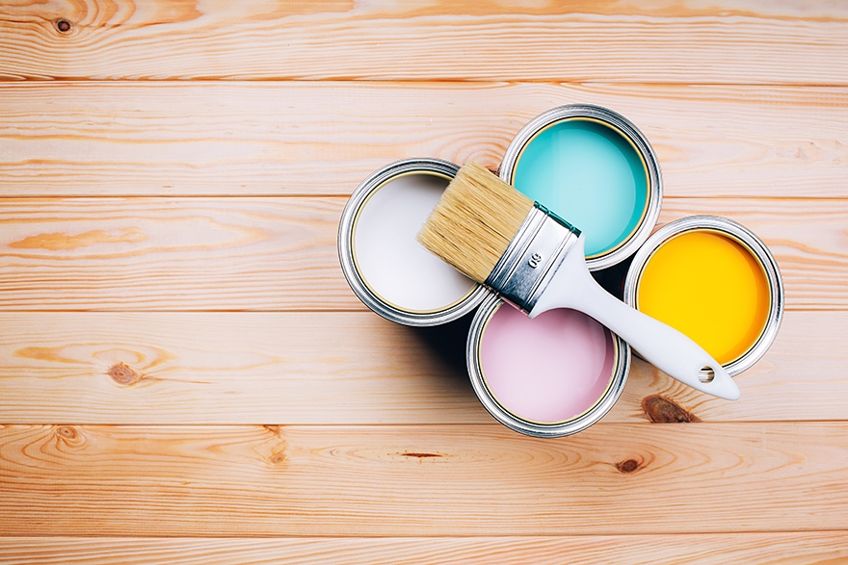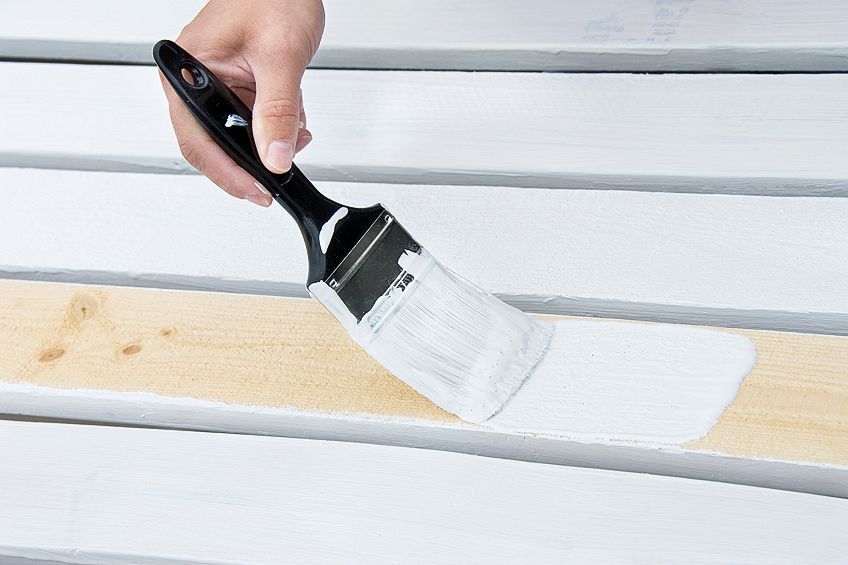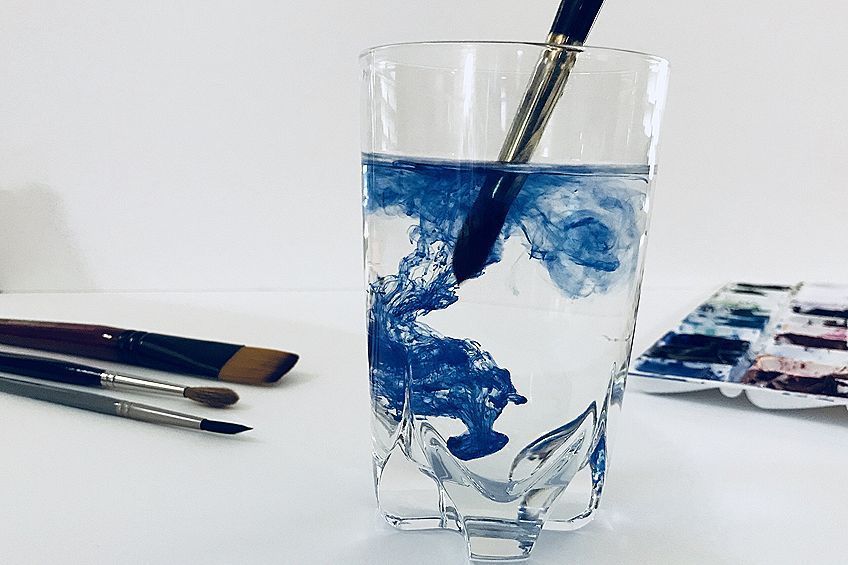Acrylic Paint on Wood – Your Guide to Acrylic Paint on Woodwork
Painting on wood is a craft that is gaining favor as painted ornaments and objets d’art have become increasingly popular, and there is a good reason for this. They bring with them the feeling of rustic coziness and make something beautiful out of something rather ordinary. The best paint to use on wood is acrylic paint, and in this article, we are going to discuss the best brands of acrylic paint as well giving you step-by-step directions for painting on wood.
Table of Contents
Can You Use Acrylic Paint on Wood?
Many people have asked similar questions. “Can you paint wood with acrylic paint?” The answer is yes, you can. However, there is some preparation to be done on the wood before you can start painting, and we will go through this process with you one step at a time. The process applies to all wood objects, from small craft pieces to wood panels and furniture.

Choosing the Right Acrylic Paint for Woodwork
There are myriad acrylic paints to choose from, and before you make your purchase there are a few things you need to do in order to ensure you get the best paint for the job. Here are some tips to help you pick the best acrylic paint for woodwork.
- Make sure the paint is acrylic paint for wood. Any other type of paint will not work well as it will not stick to the surface of the wood.
- Decide what kind of finish you want. In other words, do you want a shiny finish or a matte finish? Acrylic paint comes in different finishes, not just shiny or matte, but satin, stone, and metallic as well.
- Make sure that the paint is the right consistency. If you are working on a big piece you do not want paint that is very thin. Conversely, if you are painting a small piece, the paint should not be too thick.
- When you are choosing the color of the paint, look at the bottom of the bottle to check the color, rather than the label. Being the actual paint, the color will be more accurate.
As we have mentioned, there is a wide range of acrylic paints for woodwork to choose from, so to help you to make your choice we have looked at the premium choice of paints, as well as the best value paints and most budget-friendly.
Premium Acrylic Paint: ESRICH Acrylic Paint Set
Unleash your inner artist with this comprehensive Esrich acrylic paint set! Packed with 46 pieces of professional-grade painting supplies, this kit is a dream come true for hobbyists and beginners alike. Whether you’re experimenting with colors on canvases or refining your technique on the included easel, the set equips you with everything from a variety of paint brushes to a palette, paint knives, brush cup, and even art sponges. Dive into a world of creativity, where every stroke tells a story and every hue sparks inspiration. Whether you’re creating your first masterpiece or adding to your collection, this set ensures your artistic journey is filled with endless possibilities.
- Comprehensive 46-piece set
- High-quality materials
- Beginner-friendly
PROS
- Comprehensive Kit
- Professional-Grade Quality
- Versatile
- Suitable for Beginners
- Value for Money
CONS
- Limited Color Range
- Small Easel Size
- Not Suitable for Advanced Artists
Best Value Acrylic Paint: BENICCI Complete Acrylic Set
This set would work for a beginner as well as an experienced painter, and would also be ideal as a gift. It includes 12 brushes and 24 tubes of paint, as well as a sponge and a mixing art knife. It is a complete art kit with which you can start any project right away, large or small. Being non-toxic, the set is ideal for kids. Kids love sponge painting, and because the paints dry quickly you will be able to hang their artworks in pride of place!
- Includes 24 tubes of acrylic paint, artists brushes, sponge, and knife
- Quicky-drying acrylic paint glides like velvet onto many surfaces
- The paint is non-toxic so suitable for use by children
PROS
- Non-toxic
- Non-shed paint brushes
- Quick-dry technology
- Bright colors
- One year’s guarantee
CONS
- Paint can clump and dry out if left too long
- Tubes may be too small for medium to large painting jobs
Budget-Friendly Acrylic Paint: CRAFTS 4 ALL Acrylic Paint
This budget-friendly set comes with 24 tubes of paint and three paintbrushes. The artist-grade quality of the paints would suit anyone just starting out painting on wood, as well as crafters who have been painting for a while. The vibrant paints have been uniquely formulated for maximum color clarity and brilliance. They are also the perfect consistency for layering, blending, and creating different textures. Also, they are non-toxic so you can get your kids involved in your projects, too.
- Uniquely crafted acrylic paints deliver color clarity and brilliance
- Suitable for most mediums, including ceramic, wood, and glass
- Non-toxic composition makes the paints suitable for children
PROS
- Smooth consistency
- Vivid colors
- Perfect for wood painting projects
- Non-toxic
- Long-lasting colors
CONS
- Tubes are only 12ml (9.73 oz)
Preparing for Painting on Wood
Before you can apply acrylic paint to wood, you will need to prepare the wood. The first step is to seal the wood. This is to prevent the paint from being absorbed by the wood and causing it to rot. Sealing also stops the wood from warping due to changes in the temperature, in other words, very hot or very cold. Lastly, applying a sealant before painting creates a smoother and more even surface which makes painting a lot easier and quicker.

Bear in mind that a sealer is different from a primer. A sealer will protect the wood, while a primer ensures stronger adhesion to the wood. You need to apply the sealer first and afterward, once it has dried, you will apply the primer.
Step 1: Cleaning the Wood
Clean the piece of wood using a damp lint-free cloth and wipe it down thoroughly. If you are working with a piece of furniture or a large wood panel, it is advisable to use a vacuum or an air pressure hose to get rid of dust and debris.
You want to be sure that the wood piece you are going to paint is as clean as possible.
Step 2: Sealing the Wood
Apply a sealer over the areas that are going to be painted. A glossy sealer is best because it is non-absorbent and will create a barrier between the wood and the paint, thereby protecting the wood surface. Drying time will depend on the size of the piece you are sealing, but as a rule of thumb, the sealer dries fairly quickly.

Step 3: Sanding the Wood
You will notice that once the wood piece has dried, it will feel coarse to the touch. This is because the first coat of sealer will have raised the wood grain. You will need to sand the wood using 180-grit to 220-grit sandpaper in order to smooth the surface. There is no need to apply a great deal of pressure while you are sanding.
Alternatively, you can use a sanding machine.
Step 4: Applying the Second Coat of Sealer
Once you have sanded the piece you can either vacuum it to get rid of all the dust or wipe it with a damp microfiber cloth. Then you give the piece of wood another coat of sealer. Two coats are usually sufficient, even for large wood pieces.

Step 5: Priming the Wood
When the sealer has dried completely you will then apply a primer. By priming the wood piece, you will effectively ensure a strong adhesion between the primer and paint, and therefore you need only prime the side that will be painted.
Ensure that the primer has dried everywhere before you start painting.
The Best Primer for Wood: Rust-Oleum Painter’s Touch 2X Ultra Cover
Rust-Oleum is celebrating its centenary this year. It was founded in 1921 by a sea captain by the name of Robert Fergusson. He started the company with only 24 colors of paint and since then the company has grown to become the global leader in the manufacture of innovative coatings. That’s 100 years of expertise!
- Suitable for use on almost every exterior and interior surfaces
- The oil-based formula is low-odor, chip, and rust-resistant
- The durable formula provides excellent protection
PROS
- Manufactured for use on wood and other surfaces
- Low-odor
- Chip-resistant with long-lasting protection
- Covers up to 12 square feet per can
- Dries within 20 minutes
CONS
- Not ideal for miniature pieces
- Emits strong fumes
- May drip if applied too thick
How to Paint on Wood
Now that you have chosen the correct acrylic paint for woodwork, you are ready to start painting. We have already discussed how you should prepare the wood by cleaning it first, then applying two coats of sealer (remembering to clean the piece of wood between applications), and finally the primer.

Step 1: Transferring the Design
If you are applying acrylic paint on wood in a solid color, you do not need to follow this step. However, if you are going to paint a picture or a design onto the wood, this is how to do it. You will need a sheet of tracing paper as well as a piece of graphite paper. Take the tracing paper, lay it down over the pattern or the picture, and trace it using a dark pencil.
Place the graphite paper face down onto the wood, then put the tracing paper, picture down, onto the graphite paper and trace the picture again so it appears on the surface of the wood.
Step 2: Selecting Your Brushes
Do not be fooled into thinking that you can get away with using cheap brushes. The bristles of a cheap brush easily come loose while painting and get stuck in the paint. They may also leave visible brush strokes on the surface. The best brushes to use are made of natural hair such as sable, otherwise, look for synthetic brushes that do not shed. Generally speaking, a soft brush is preferable to a stiff one. Needless to say, you will be sure to select the appropriately sized brush for the painting you will be doing.

Step 3: Setting Out Your Paint
Acrylic paint is available in bottles, tubes, and tins. If you are using paint from a bottle or a tube it is a good idea to squeeze some out onto an artist’s palette or even a dinner plate. That way you will not waste any paint or overload your paintbrush. If you are using a tin of paint, do not dip your paintbrush all the way into the paint.
Only dip it halfway, and wipe it down of excess paint before you apply it to the wood.
Step 4: Keep the Paint Liquid
Acrylic paint has a reputation for drying very quickly. This is another reason why you should not squeeze too much paint onto your palette because it could dry out. In the same way, you need to keep your paintbrush wet – but not too wet that it lightens the color. Keep a jar of water close by, and after every couple of applications dip your paintbrush into the water and wipe off excess water on a piece of paper towel.

Step 5: Seal the Paint
If you have used acrylic paint that has a built-in sealer, you will not need to seal the paint. If not, you will want to protect the paint and the surface of the wood and for this, you will need a sealer. You can use a brush-on sealer such as Minwax Polycrylic Protective Wood Finish, or a clear acrylic spray.
This step is not compulsory, but it will ensure that your decorated piece of wood lasts as long as possible.
The Best Sealer for Wood: Minwax Polycrylic Protective Wood Finish
Minwax was founded in Brooklyn, New York in 1904. At first, it catered to the industrial market, but in the late 1940s, it moved into the consumer market. At present, their Polycrylic Protective Wood Finish is the most popular wood sealer available.
- Offers excellent protection for painted wooden surfaces
- The crystal clear protective coating works for all wood types
- Water-based formula can be easily cleaned with soap and water
PROS
- Long-lasting clear finish
- Ultra-fast drying
- Water-based and easy to clean
- Low odor
CONS
- May yellow with age if exposed to light
- Will cause bubbles if not applied evenly
Some Ideas for Acrylic Paint on Wood Crafts
So, in answer to your question, “Does acrylic paint work on wood?”, yes, it works very well. We have also shown you how to prepare wood for painting, how to paint it, and also how to finish it off. You probably have a list of ideas for the projects you want to do, but in case your list is not as long as you would like, we have a few ideas of our own.
- Halloween decorations: We all love fall and the changing colors of the leaves, as well as jack o’ lanterns and trick or treating. In addition to candy treats, you could make miniature wood pumpkins painted bright orange, or leaves made of wood and painted in all the colors of fall. You can hang these on the porch or in your entrance hall to celebrate the season, and, like Christmas decorations, you can enjoy them year after year.
- Christmas decorations: Why not decorate the tree with personalized decorations for every member of your family? Get the kids to paint decorations too. They might not be seasoned painters, but their decorations will become the most treasured on the tree! Being wood decorations, they will last a long time and can therefore be brought out every year at Christmas time.

- Wood furniture: Acrylic paint on wood furniture will give your old and tired furniture a new lease of life, furniture such as your porch swing, or your backyard table and chairs. Even though it is outdoor furniture, if you prime and seal the wood properly the paint should last a long time. That said, there is nothing preventing you from applying another coat of sealer after a few months, particularly if you live in a hot, sunny climate.
- Kids’ and babies’ toys: Most toys these days are made of plastic, so toys made of wood and painted by hand would be very special, not only for the child but also as an heirloom for future children. Think of babies’ mobiles hanging over a cot, or a doll’s house painted in favorite colors, or even a brightly-colored train set. There are endless options. Acrylic paint on wood crafts finishes them off beautifully and ensures they will be able to withstand the rough and tumble of kids’ playtime.
Now that you know the dos and don’ts of painting on wood, specifically, acrylic paint for woodwork, you can start your painting project with confidence. We have given you a few ideas to start with, and we are sure that you will have many ideas of your own. Painting on wood is a lot of fun, not only for experienced crafters but also for beginners and kids, too.
Frequently Asked Questions
Can You Paint Wood With Acrylic Paint?
Yes, you can, although you cannot use just any type of acrylic paint. It must be specially formulated acrylic paint for woodwork. We have included reviews of three of the best acrylic paint sets in this article, and you are sure to find one that suits not only your project but your pocket as well.
Does Acrylic Paint Work on Wood?
Only acrylic paint that is manufactured specifically for wood will work. Make sure that the paint is the right consistency. If you are painting a big piece of wood the paint should not be too thin. Conversely, if you are painting a small piece of wood, the paint should not be too thick. Lastly, when you are choosing the color, look at the bottom of the bottle to check the color, rather than the label.
Does the Wood Have to be Prepared Before Painting?
Yes, it does, and this goes for small pieces like a child’s toy or a rustic-looking sign for your hallway, as well as wood panels and furniture. First, you need to clean the piece to get rid of dust and debris, then apply two coats of sealer (allowing the first coat to dry before applying the second coat). When the second coat has dried you will then apply a primer.
Does the Paint Have to be Sealed Once Dried?
It is entirely up to you whether you want to seal the paint when it has dried. Some acrylic paints are made with a built-in sealer so if you have used that type of paint then there is no need to apply an additional sealer. That said, you do not have to seal the paint – but if your painted piece is going to be exposed to the weather then it is probably a good idea to apply a sealer. It is simply an added protection for the paint.
In 2005, Charlene completed her Wellness Diplomas in Therapeutic Aromatherapy and Reflexology from the International School of Reflexology and Meridian Therapy. She worked for a company offering corporate wellness programs for a couple of years, before opening up her own therapy practice. It was in 2015 that a friend, who was a digital marketer, asked her to join her company as a content creator, and this is where she found her excitement for writing.
Since joining the content writing world, she has gained a lot of experience over the years writing on a diverse selection of topics, from beauty, health, wellness, travel, and more. Due to various circumstances, she had to close her therapy practice and is now a full-time freelance writer. Being a creative person, she could not pass up the opportunity to contribute to the Art in Context team, where is was in her element, writing about a variety of art and craft topics. Contributing articles for over three years now, her knowledge in this area has grown, and she has gotten to explore her creativity and improve her research and writing skills.
Charlene Lewis has been working for artincontext.org since the relaunch in 2020. She is an experienced writer and mainly focuses on the topics of color theory, painting and drawing.
Learn more about Charlene Lewis and the Art in Context Team.
Cite this Article
Charlene, Lewis, “Acrylic Paint on Wood – Your Guide to Acrylic Paint on Woodwork.” Art in Context. November 29, 2021. URL: https://artincontext.org/acrylic-paint-on-wood/
Lewis, C. (2021, 29 November). Acrylic Paint on Wood – Your Guide to Acrylic Paint on Woodwork. Art in Context. https://artincontext.org/acrylic-paint-on-wood/
Lewis, Charlene. “Acrylic Paint on Wood – Your Guide to Acrylic Paint on Woodwork.” Art in Context, November 29, 2021. https://artincontext.org/acrylic-paint-on-wood/.














